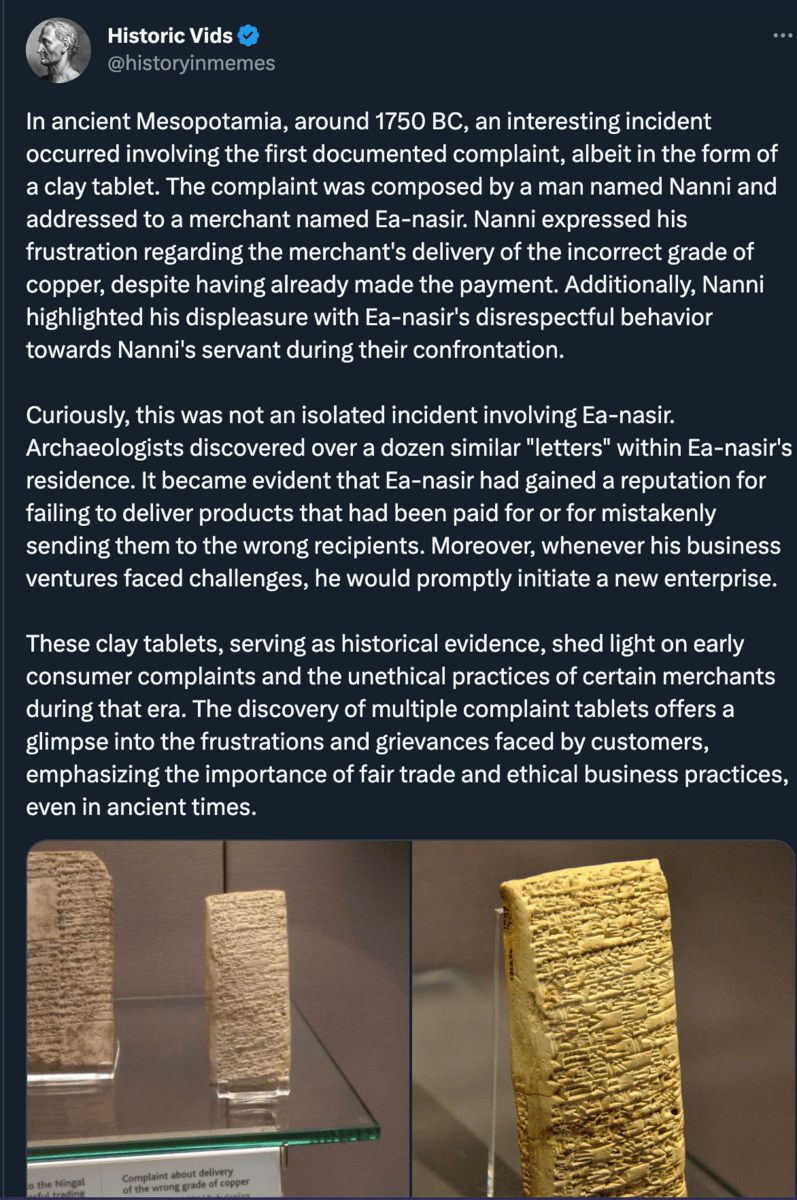- The Lindy Newsletter
- Posts
- The Internet is Not Forever
The Internet is Not Forever

"Be careful what you put on the internet, it may be there forever"
I hard this statement when I first logged onto the internet and I keep hearing it as an adult. Every successive generation who logs on hears it as well. It’s the last boogeyman that survives in a post-superstition world.
This phrase doesn’t have a specific origin, it just always existed. It reflects a common understanding of the nature of the internet and its implications. What you write or post on here, using your real name (or not) will be here forever. The phrase highlights the fact that once something is posted on the internet, it can be difficult to completely erase or remove it. Someone finds something you wrote when you were 15 and they fire you when you’re 45 with a wife and kids. The boogeyman. Thus people exercise caution and think about the potential long-term consequences of their online actions.
What if the opposite is true? All this online content isn’t going to survive the end of the decade. During the last few weeks there has been announcements by a variety of companies on deleting old content and accounts:
1) Elon Musk announced that Twitter will be deleting accounts that have been inactive for several years. He vaguely hinted at “archiving” but didn’t provide details.
2) Google announced a new policy of deleting inactive Google accounts. The new deadline is also 2 years. They clarified it doesn’t apply to Youtube videos yet, but that’s probably coming next.
3) The very popular photo hosting site Imgur said it will begin removing “old, unused and inactive content....”
4) The Millenial website Buzzfeed news shut down. They put up a website for the archive, but it isn’t searchable. Who knows how long it stays up. It used to be a place that many writers wanted to work at. $75/year to maintain a website that hardly no one reads. At some point you turn it off and that information is gone forever.
It is no coincidence it is happening now. Interest rates have risen fast this past year.

When interest rates rise, the cost of borrowing increases. Businesses often rely on borrowed money for various activities like expanding operations, funding new projects, or even managing cash flows. When interest rates are low, companies can borrow cheaply, reducing the urgency to generate profits. But when rates rise, the cost of servicing debt also rises, increasing the need for profits to cover these costs. Although companies always need to generate profits, the end of a zero interest rate environment makes profitability even more critical.
Borrowing is expensive now. These internet companies now need to make money. You may have noticed the massive amount of layoffs at tech companies lately. One way to cut cost is to stop storing data.
Think of how much the internet has grown during that time. Even today, it’s just dead links everywhere once you start looking at websites before 2008. “It feels like early social media internet (~2004-2012 or so) is entirely gone from the record.” Remember Myspace? Most of it cannot be found. Or Geocities or Angelfire.

The Implications
If the internet is slowly being deleted, that brings up a whole host of issues. In this Newsletter I’ll cover a few them:
1) How do we store content and make sure they are not deleted?
2) Now we know the internet is not a “Lindy Machine”. How did works from Ancient Greece and Ancient Rome get to us in the present day? Who preserved them and transmitted them?
3) Everyone can create art today because all the creative tools are democratized. But not everyone has an audience. Do you need an audience to create art? Let’s focus on the example of Kafka, who was only published and became famous after his death.
4) The cult that surrounds the The Internet Archive and the Wayback Machine.
Storing Information
The firs thing people say about storing content (writing, videos, audio, photos, etc) is just put everything in the cloud and everything is ok.
Will you be able to access cloud storage in 100 years? 1000? If we’re discussing long time scales the cloud has vulnerabilities. As technology evolves, file formats, software, and storage systems can become outdated. Compatibility issues will arise when attempting to access files created with older technologies. Remember the floppy disk?
The cloud exists in perpetuity in theory but companies who maintain the storage don’t. Cloud service providers may go out of business. Or if they do not go out of business, their change in Terms of service could determine ownership or accessibility of your content in the long term. Who knows what new laws could be passed. Maybe future Privacy laws force them to delete Personal Data in the compliance.
To mitigate these concerns, you’re supposed to combine cloud storage with other backup solutions that are local and physical. But which ones?
Hard drives last anywhere from 5-20 years
CDs are estimated to last 30-50 years
If you really wanted to get serious you can go the Cuneiform Tablet route.

Cuneiform tablets were primarily made of clay. After the tablet was inscribed, it was often dried in the sun or baked in a kiln to harden the clay, making it more durable and preserving the writing for an extended period. Once hardened, the tablet became a permanent record of the text or information it contained.
We have tens of thousands of these tablets around today. Most of them are untranslated. Why? Because they were only used for accounting and administrative purposes. Things like economic transactions, inventories, contracts, legal agreements, and administrative matters. It’s just business. They exist. But are not interesting. It’s a Microsoft Excel spreadsheet. Although, to be fair, some of them are funny.

But we are thinking about content storage the wrong way. We shouldn’t rely on materials or technology. We should rely on people or institutions. That’s how things have always been transmitted throughout history. People hand it off to the next generation. There is trust involved that this content is useful, good or at least not harmful.
Transmitting Ancient Literature
Seneca, Plato, Socrates, Sappho and more are read today but how did they get here? These texts are thousands of years old. The originals are long gone, they were not written on Cuneiform tablets and no ancient library has survived to the present day. These works survived by being copied by people. Books themselves have a limited lifespan, regardless of format — scroll or codex, papyrus or acid-free paper, monograph or miscellany. The books that survive are the ones that were copied, and copied, and copied again, usually many times over the centuries.
The story of Ancient Literature are a long one because they were split depending on language. As Peter Gainsford writes, Latin texts were preserved in western Europe, especially Italy, Germany, and France. After the fracturing of the Roman empire and the chaos of the 6th century, it devastated secular libraries, so monastic copying became the main road to a text’s survival. Lay scholars, began to play an important role from the 14th century onwards. For a good book on this phenomenon try reading The Name of the Rose by Ecco. The monastic collections usually ended up in university or state archives where they sit today.
The preservation of Greek texts happened in the Eastern Roman Empire, centered around Constantinople. Initially, church leaders held sway over the book culture, but Emperor Konstantinos VII Porphyrogennetos (r. 913-959) played a pivotal role in promoting scholarship beyond the church's domain. During the latter half of the 900s, the Souda, one of the renowned Byzantine encyclopedias, was compiled, marking a significant milestone in Byzantine book culture. After the Ottoman Conquest the copying went back to church monasteries.
How do we ensure our content is preserved? We have to trust people, not technology. But trusting people today isn’t easy. Are your family members going to keep procreating? Many people aren’t bothering to have kids anymore. Your line could end in a generation or two. Who’s passing down the USB stick or whatever format your photos or songs or writing that you put on there? Every person born during the past 15 years has thousands of photos of them taken. Whereas in the past you had a handful. Ironically, the thousands of photos may not even make it past a few generations.
Or should you give it to an institution that plans on sticking around for a long time. Which one is that though? I don’t think the university is taking your stuff. And the university may not even be around in a century or two. The Church? That will probably be around for a long time but I doubt they want to take your works either. Who are you?
Storing content seems like an issue we have solved. But we haven’t. Even with a time scale of 100-200 years, which is nothing, compared to how long Plato has been transmitted throughout history we aren’t sure what’s going to be around. Transmission is based on people and institutions, not technology. But people and institutions are going through changes. Transmitting things across generations is hard now.